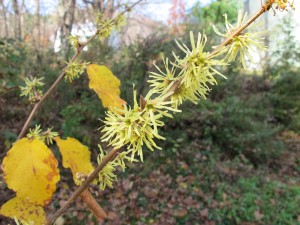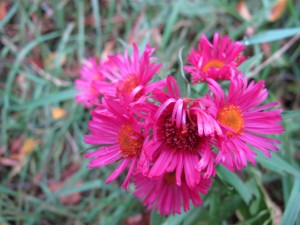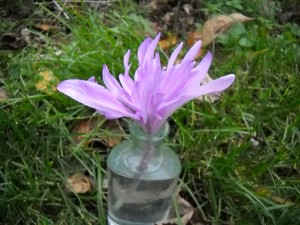What’s Blooming Now in the Garden
By mid to late October, many gardens are looking quite drab. That need not be the case, and this week I’d like to mention a few of the flowering plants that are cheering up my gardens now.
Witch hazel (Hamamelis virginiana) is a native shrub that grows in the understory and blooms now (or in the early spring, for Hamamelis x intermedia). The flowers are not dramatic on most varieties– they are less than in inch in diameter, and are arranged close to the stem. Although I’ve seen witch hazel in a public garden that had red blossoms, the native species that I grow is a pure yellow and the petals are very frilly – you could say “spider-like”. The look best after leaf drop.
As a kid I went to a barber who used a witch hazel tonic as an astringent after shaving men. To make us kids feel more grown up, perhaps, he applied some on the back of our necks when he was done with us. It is a very fresh scent that is made from the bark of young stems and roots of the shrub. The leaves, when crushed, also have a nice smell.
My Seven-Sons Flower Tree (Heptacodium miconioides) is still blooming now. This is a smallish tree (under 30 feet tall), but one that grows extraordinarily fast. It is not unusual for new stems to grow 3 to 5 feet in a season. I love the bark, which is exfoliating (shaggy). Its flowers are small and white, and appear in panicles (clustsers).
I am experimenting with mine to see how it does as a pollarded tree. Pollarding is a process of cutting off most new branches back to major branches every few years, keeping the size in check and crating large knobs where new growth originates. It’s a very popular pruning technique in Europe. Last year I cut off all the smaller branches, leaving a trunk and three major branches. This year I got dense clusters of branches growing from the ends of those major branches. Interestingly enough, many of the new stems are growing out and down, almost like a weeping tree.
Chrysanthemums great fall flowers that I buy in pots each year around Labor Day. I treat mums as annuals, even though some varieties will overwinter. Why? Because to get a dense, compact plant, one must pinch back the growing stems two or more times during the summer, and I have too much going on to remember to do so most years. There are people who do this for a living, and I am happy to let them do it. I like mums in window boxes (the smaller ones) and the big, dramatic ones in pots on my front steps. When they come in peat or cardboard pots I transplant them into plastic pots as the former dry out too quickly.
Fall asters have been splendid this year, both those that I planted and those growing along the roadside or edges of fields. The wild ones are mostly blues and purples. I purchased a pink aster that is in bloom right now, a variety called ‘Alma Plotschke’. She is an intense, deep rose pink and not nearly as tall as the wild ones.
Some smaller wild asters(12 to 24 inches tall are blooming at the edge of my lawn. My reference text on native flowers (The Illustrated Book of Wildflowers and Shrubs by William Carey Grimm) lists 29 species of wild asters. These short ones have bluish-white blossoms. I believe mine are the common blue wood aster (Aster cordifolius), which is usually a light blue or lavender. The differences between wild asters can be minute and there is much variety within a species, so they could be the white wood aster (Aster divaricatus), which is also common in New England. It doesn’t matter, they’re all lovely.
Fall crocus are wonderful! True fall crocus (Crocus sativus) are not fully hardy in my cold Zone 4 garden. Various vendors list them as hardy to Zone 4 or 5 or 6. I have had them winter over, and have a client nearby who has had them blooming each fall for years – in a Zone 4 garden. These crocus are the source of saffron, but I’ve read that it takes 10,000 flowers to make an ounce of saffron!
Colchicums are also called fall crocus, but are not true crocus. They look like crocus on steroids – they are commonly 6 inches tall! I planted a lot 10 years ago, but each year I have a few less. Unfortunately their stems do not usually support the flowers, so they flop. To avoid this I have planted them in amongst a ground cover like myrtle (Vinca minor) that helps to hold them up. Mine are mainly pink, but also have a few white, both as singles and doubles.
Some annual flowers hold up against frost for awhile, too. My favorite right now is Brazilian verbena (Verbena bonariensis), which is hardy down into the 20’. It grows three feet tall on thin, stiff stems with little clusters of purple-blue flowers. The flowers seem to float above shorter things. Look for it next summer.
Fall flowers are a gift. Even when I’m thinking about woodpiles and snow shovels, a few hardy plants keep on bringing me joy.
Henry is the author of 4 gardening books and a children’s book about a boy and a cougar. His Web sites are www.Gardening-guy.com and www.henryhomeyer.com.





